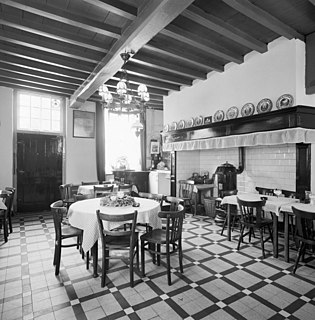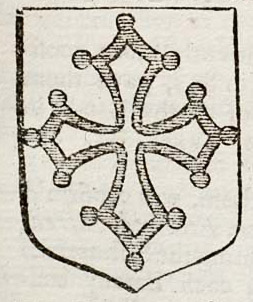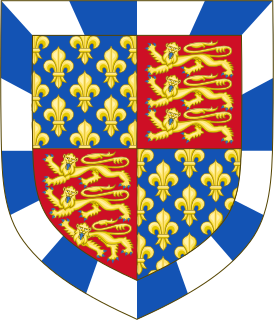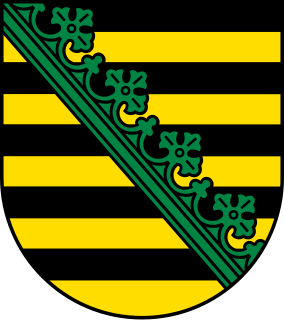In heraldry, gules is the tincture with the colour red. It is one of the class of five dark tinctures called "colours", the others being azure (blue), sable (black), vert (green) and purpure (purple).

The fylfot or fylfot cross is a type of swastika associated with medieval Anglo-Saxon culture. It is a cross with perpendicular extensions, usually at 90° or close angles, radiating in the same direction. However – at least in modern heraldry texts, such as Friar and Woodcock & Robinson – the fylfot differs somewhat from the archetypal form of the swastika: always upright and typically with truncated limbs, as shown in the figure at right.

Brian Walton was an English Anglican priest, divine and scholar. He is mostly remembered for his polyglot Bible.

Cyclopædia: or, An Universal Dictionary of Arts and Sciences is an encyclopedia prepared by Ephraim Chambers and first published in 1728; six more editions appeared between 1728 and 1751 with a Supplement in 1753. The Cyclopædia was one of the first general encyclopedias to be produced in English.
In heraldry, sable is the tincture black, and belongs to the class of dark tinctures, called "colours". In engravings and line drawings, it is sometimes depicted as a region of crossed horizontal and vertical lines, or else marked with sa. as an abbreviation.

A cross fleury is a cross adorned at the ends with flowers in heraldry. It generally contains the fleur-de-lis, trefoils, etc. Synonyms or minor variants include fleuretty, fleuronny, floriated and flourished.

Ermine in heraldry is a "fur", a type of tincture, consisting of a white background with a pattern of black shapes representing the winter coat of the stoat. The linings of medieval coronation cloaks and some other garments, usually reserved for use by high-ranking peers and royalty, were made by sewing many ermine furs together to produce a luxurious white fur with patterns of hanging black-tipped tails. Due largely to the association of the ermine fur with the linings of coronation cloaks, crowns and peerage caps, the heraldic tincture of ermine was usually reserved to similar applications in heraldry.

In heraldry, an annulet is a common charge. It may allude to the custom of prelates to receive their investiture per baculum et annulum, and can also be described as a roundel that has been "voided". In English and Canadian heraldry it is also used as the difference mark of a fifth son.
Antejuramentum, and præjuramentum, historically called juramentum calumniæ, is an oath which both the accuser and accused were obliged to make before any trial or purgation. The accuser was to swear that he would prosecute the criminal, and the accused was to make oath on the very day that he was to undergo the ordeal, that he was innocent of the claims of which he was charged. If the accuser failed, the criminal was discharged. If the accused failed, he was intended to be guilty, and was not to be admitted to purge himself by the ordeal. The name of this oath, "Antejuramentum", is law latin.
The Arrhabonarii were a Polish Christian sect who held that the Eucharist was not a present gift of grace but was a pledge of a gift to be bestowed in heaven. The sect's name is derived from the Greek Ἀρραβων, Arrha, meaning "earnest". The position was first argued by Francesco Stancaro in 1543.

In heraldry, a bordure is a band of contrasting tincture forming a border around the edge of a shield, traditionally one-sixth as wide as the shield itself. It is sometimes reckoned as an ordinary and sometimes as a subordinary.

A bressummer, breastsummer, summer beam is a load-bearing beam in a timber-framed building. The word summer derived from sumpter or French sommier, "a pack horse", meaning "bearing great burden or weight". "To support a superincumbent wall", "any beast of burden", and in this way is similar to a wall plate.

In heraldry, cabossed, or caboched, is a term used where the head of a beast is cut off behind the ears, by a section parallel to the face; or by a perpendicular section: in contrast to couping, which is done by a horizontal line, and farther from the ears than cabossing.

Cercelée, or sarcelly or recercelée, is a term in heraldry. A cross cercelée is like an exaggerated cross moline, and to a lesser extent similar to the anchored cross, with its forked tips curving around both ways, like a ram's horns. The form is also known as recercelée, for example by Boutell.
A chapeau is a flat-topped hat once worn by senior clerics.

In heraldry, a cross cleché, or clechée, flares out at the ends in a shape resembling the bow of an old-fashioned key. An example is the Occitan Cross in the coat of arms of the counts of Toulouse: Gules, a cross cléchée, pommetty and voided Or.

In heraldry, an ordinary componée,, anglicised to compony and gobony, is composed of a row of squares, rectangles or other quadrilaterals, of alternating tinctures, often found as a bordure, most notably in the arms of the English House of Beaufort.

In heraldry and heraldic vexillology, a blazon is a formal description of a coat of arms, flag or similar emblem, from which the reader can reconstruct the appropriate image. The verb to blazon means to create such a description. The visual depiction of a coat of arms or flag has traditionally had considerable latitude in design, but a verbal blazon specifies the essentially distinctive elements. A coat of arms or flag is therefore primarily defined not by a picture but rather by the wording of its blazon. Blazon is also the specialized language in which a blazon is written, and, as a verb, the act of writing such a description. Blazonry is the art, craft or practice of creating a blazon. The language employed in blazonry has its own vocabulary, grammar and syntax, which becomes essential for comprehension when blazoning a complex coat of arms.

Erasure in blazon, the language of heraldry, is the tearing off of part of a charge, leaving a jagged edge of it remaining. In blazons the term is most often found in its adjectival form, erased, and is usually applied to animate charges, most often heads or other body parts.

Crancelin is a charge in heraldry, usually seen in the bend on a shield. It depicts a band of a stylized trefoil leaves, representing a branch of common rue. It can be found in the coat of arms of Saxony. Legend has it that at the investiture of Bernhard, Count of Anhalt and Ballenstedt, as Duke of Saxony, the then emperor, Frederick I Barbarossa, took the chaplet of rue he was wearing and placed it over the corner of Bernhard's shield. To commemorate this act, the crancelin vert was added to the Ballenstedt arms.















